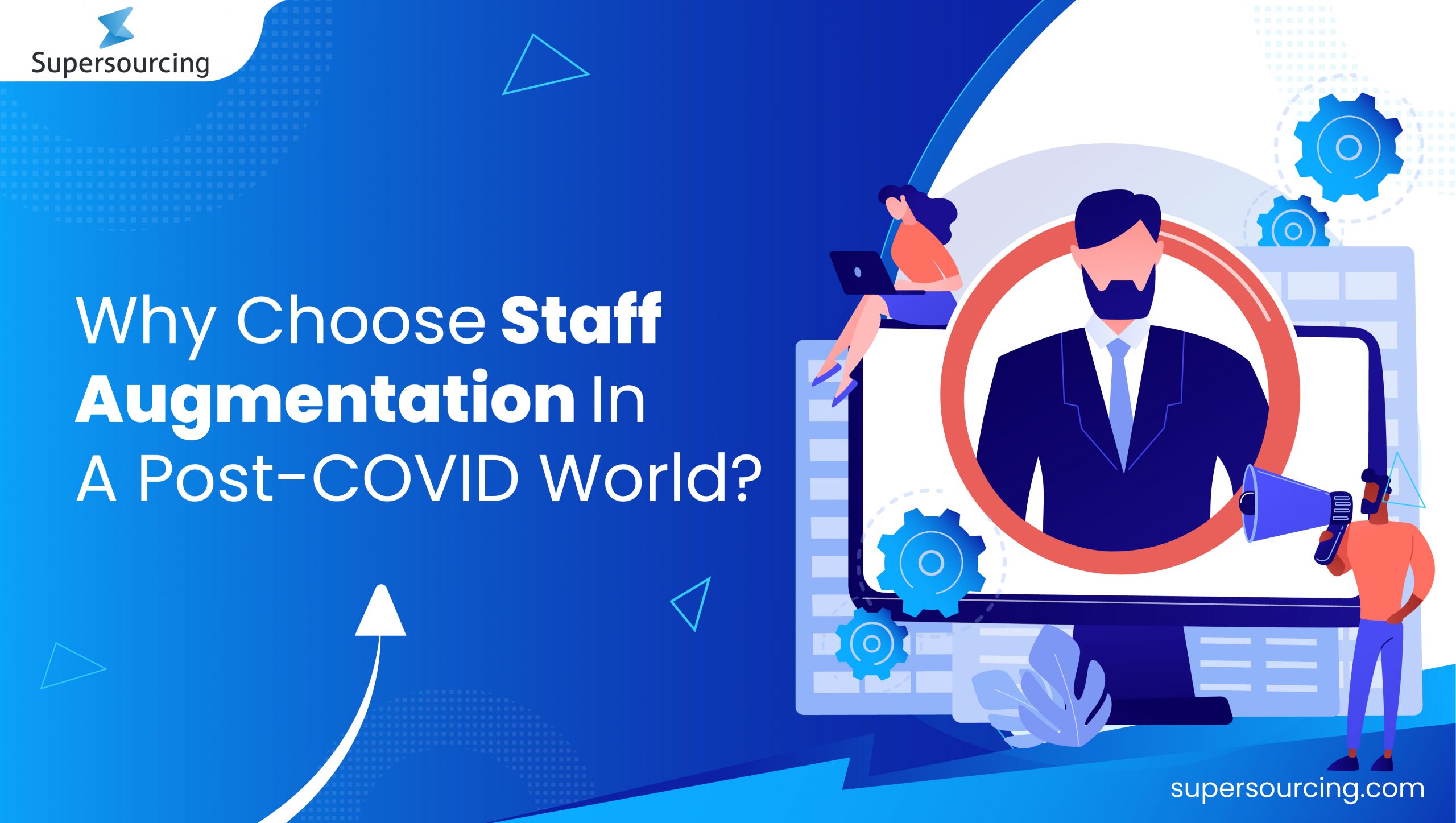Table of content
In the year 2003, two friends hired a small team of developers from Estonia to build a peer to peer messaging platform. The platform was later bought by eBay and then Microsoft for a whopping $8.5 Million. Today, it is one of the leading instant messaging platforms in the world. That platform was Skype, and the prologue of Skype’s success story was written with the help of the Staff Augmentation model.
Staff Augmentation is not a new concept, organizations irrespective of their size and domains have been using it to bolster their organizational skillsets for meeting customer requirements and optimizing business processes.
The software industry has been leveraging the benefits of the Staff Augmentation model for aeons. This has helped them expand their service offerings and grow faster, but with a lean team and optimized costs.
In this article, we will cover why Staff Augmentation has become crucial in the post COVID world, its benefits, and the key factors to consider while choosing the perfect staff augmentation partner for your enterprise.
Staff Augmentation: Need of the hour in Post-COVID World
Companies adopting the Staff Augmentation model grew in numbers post-pandemic. However, this shift was already underway slowly and steadily. As per a Statista report, the global outsourcing market in 2019 was $92.5 billion, which grew to $132.9 billion in the post-pandemic world.
Prior to COVID-19 also, enterprises have explored the Staff Augmentation model in times of crisis. During the 2008 recession, Toyota had to lay-off many full-time employees to survive the slowdown. Letting go of their workforce was definitely a difficult decision, but at that point in time, it was a necessary one. After this incident, Toyota augmented its variable workforce to optimize costs and avoid repeating the history.
With the onset of the COVID-19 pandemic, enterprises across the globe have faced many unprecedented challenges. Maintaining business continuity while ensuring employee well-being and safety, being the most critical one. Issues like logistical difficulties of enabling remote working, the impact of COVID-19 on employees’ health, uncertainty of getting new business, etc., led to a lot of financial and operational challenges for enterprises of every scale. Additionally, enterprises also realized that the much-needed skillsets for functioning in a post-pandemic world were in short supply.
In this scenario, Staff Augmentation proved to be a boon for companies trying to meet client deliverables, continue with their ongoing projects, and keeping their businesses afloat. In a post-COVID world, the concepts of office spaces and geography seem redundant and this trend will continue long after the pandemic is over. The reason: prudent organizations have realized the benefits of augmenting their workforce compared to building their teams from scratch.
COVID-19 gave an opportunity to business leaders across the globe to re-think how they organize their workforce to drive maximum value. Earlier, most enterprises were using Staff Augmentation for roles like web and graphic design, search engine optimization, content writing, translation and interpretation, digital marketing, branding, legal services, etc. Now the organizations are augmenting their product and software development teams, IT teams, HR teams, too, using this model. Additionally, companies have also started considering people for senior positions and CXO levels on a contractual basis.
Advantages of Staff Augmentation in the New Normal
According to Gartner Research – organizations will continue to expand their use of contingent workers to maintain more flexibility in workforce management post-COVID-19 and will consider introducing other job models they have seen during the pandemic, such as talent sharing and 80% pay for 80% work.
“32% of organizations are replacing full-time employees with contingent workers as a cost-saving measure.’’ – Brian Kropp, Distinguished Vice President, Gartner.
In the current times when businesses are struggling to break even, there is more to gain by embracing remote workers than hiring full-time employees. Global Workplace Analytics estimates businesses save about $11,000 per employee each year for every employee who works remotely half the time.
Some key benefits of Staff Augmentation are:
1. Business Continuity
Staff augmentation is the perfect solution for enterprises in times like these while they continue to face operational, logistical, and innovation challenges. It allows enterprises to hire professionals with hands-on experience in not just tools and technologies that they need currently, but it also helps them prepare for the future.
2. Staff Augmentation is not just 1…2… but light years ahead of the traditional outsourcing models
Staff Augmentation is light years ahead of the traditional outsourcing models. It is much more than hiring gig-workers for a project. Staff Augmentation is a hybrid model where in-house teams and remote developers work together to deliver a software solution within a specified timeline. In a Post-COVID world when on-time delivery is a challenge that enterprises face, Staff Augmentation can help them achieve their goals and meet client deliverables right in time.
3. Cost Optimization
COVID-19 has had a crushing impact on the financial stability of organizations across domains. With lay-offs and unavailability of employees owing to lockdowns, health issues, etc. managing deliverables continues to be a herculean task. Training employees on new skill sets will have cost and time implications. A survey suggests that a large number of recruiters believe that finding skilled employees is a challenge. It is an uphill task to look for the right set of people. Staff Augmentation solutions in this scenario can be useful to quickly scale up and meet deliverables.
Further, hiring permanent employees will also have cost factors like – full-time salary irrespective of their engagement, payroll taxes, employee benefits, social security, and more. Staff Augmentation services can help enterprises forget about all this and continue to meet client commitments.
4. Managing Unexpected Attrition and Meeting Deliverables
During the pandemic, while enterprises were forced to lay off their teams, many also faced the challenge of growing rates of staff attrition resulting due to the rising number of COVID cases. Many people had to leave their current jobs to take care of an ailing family member, or kids, etc. A Staff Augmentation can help enterprises bridge the resource gap and ensure that the crucial projects get completed on-time.
5. Scale Up or Down with ease
The COVID-19 situation is still evolving, and business dynamics continue to change. In this situation, organizations will have to swiftly adjust their workforce requirements depending on the need of the hour. During this time, letting go of employees can be difficult. It can adversely affect the brand image of a company and hamper the morale of the current workforce. Hiring or training, on the other hand, will have cost implications. In this situation, Staff Augmentation can give enterprises the flexibility of scaling up and down their workforce based on project requirements without the fear of the above-said factors. This also gives enterprises the freedom to experiment on multiple fronts at the same time without having to expand their teams.
6. Time is One of the Most Valuable Assets
During the COVID-19 pandemic, businesses across domains were forced to change their processes and innovate within just a matter of a few months. From brick and mortar introducing virtual storefront platforms to live streaming of product launches, contactless deliveries, and more, pandemic accelerated innovation and digital transformation for all domains. The pace of innovation continues to rise. In this scenario, hiring talent with the required skill sets can be time-consuming. Staff Augmentation can help organizations innovate faster with a leaner team. The staffing company takes care of all the legal responsibilities, paperwork, background checks, and more. At the same time, enterprises can focus on innovations too.
7. Complete Control over the Project
The key difference between outsourcing and augmenting the workforce is the control that each model allows. Outsourcing a project can be an opaque process with limited control over the deliverables. With Staff Augmentation, the control of the project remains with the parent enterprise and helps them manage the project as per their processes, timelines, and convenience.
8. High Productivity Level
A Staff Augmentation model boosts productivity for an enterprise since teams focus on a single project and not multiple projects in a given time. This is not the case with outsourcing. Additionally, even when the augmented staff is not on the permanent payrolls of an enterprise, they pretty much operate as a part of the team. Hence, this boosts their motivation to work.
9. Geography is No Longer a Barrier
In the wake of COVID-19, while enterprises look for cheaper resources, they also want to expand business in new geographies. With the Staff Augmentation model, both are possible. While enterprises can hire resources that can help them save costs. Owing to a location advantage, they can also leverage the benefits of exploring new territories with local resources in untapped markets.
Key factors to consider while choosing a Staff Augmentation partner for your enterprise
1. A Clear Objective
Being clear on project goals, required skill sets, and timelines will help in starting at the right foot and avoid ambiguities that can derail projects’ progress and delay deliverables.
2. Assessing Expertise of the Staff Augmentation Partner
It is important to assess the expertise of the augmentation partner on all fronts. While looking for a Staff Augmentation company, it is important to look for third-party reviews. Such as past work, and client testimonials to gauge their experience and expertise.
3. Ensure the Staff Augmentation Partner has the Right Skills
Before the dotted line is signed, it is important to ensure that the staff augmentation partner has the right skills in place. Doing additional rounds of technical interviews with the resources can be a great way to ensure the team has the right skills as per the project requirements.
4. Quality Control Measures
Looking at the quality monitoring systems followed by the Staff Augmentation partner is a critical factor. It is important to choose a partner who can provide a transparent view of their workflows. Along with ways of tracking and monitoring the ongoing project’s progress.
5. Geographical Strength
It is important to choose a Staff Augmentation partner who can support your business on a long-term basis and not just for a one-off project. In this context, ensuring that the Staff Augmentation partner can support your organization. Both in locations, you operate currently and are planning to operate in the future.
Wrap Up
While businesses are on their road to recovery, challenges of business continuity, cost optimization, and more continue to hover. COVID-19 has led to permanent changes in the way organizations operate. Faster and leaner is a mantra that businesses will follow while re-thinking their workforce. In this scenario, Staff Augmentation will prove to be a critical element of workforce planning for 2021 and beyond.







